HISTORY AND ARCHEOLOGY
Nearly 7000 years ago, during the Neolithic period, fishermen had founded a small village by the sea, of which some vestiges can still be seen: floors of single-cell huts covered with a lime plaster. These primitive settlements yielded a large quantity of flint tools and weapons dating from this period.
This way of life continued during the Chalcolithic period (4000-3000 BC) with, however, new funerary practices consisting of burying the deceased in large jars, accompanied by modest funerary furniture.
Around 3000 BC. J. – C., Byblos knows a good development thanks to the flourishing trade of the wood which it exports in Eastern Mediterranean and more particularly in Egypt. At that time, the pharaohs of the Old Empire sought wood for their naval constructions as well as for their funeral rites. In return, they sent to Byblos gold and alabaster objects, rolls of papyrus and linen fabrics. Thus began for Byblos a period of great prosperity and intense commercial activity.
A few centuries later, the city fell prey to an invasion of the Armorites who set it on fire. But once installed, they rebuilt the city and reestablished trade with Egypt. It is also from this period that the royal tombs of Byblos date, which show, through their rich contents, the renewed prosperity of the city.
Around 1200 BC. J.-C., a wave of what it is agreed to call the Peoples of the Sea spreads in the Eastern Mediterranean and certain groups of them are established on the southern coast of the country of Canaan. It is these newcomers who probably instilled their marine knowledge in the populations of what will one day be Phenicia.
Meanwhile, the scribes of Byblos developed a new writing system, the phonetic alphabet. One of the oldest inscriptions using this alphabet is the one engraved on the sarcophagus of King Ahiram of Byblos, now in the National Museum of Beirut. During the 9th-8th centuries, this system was introduced in Greece and became, through Greek and then Latin, the ancestor of all modern alphabets.
During the first millennium, and despite harassment from the Assyrians, Babylonians and Persians, Byblos continued to profit from its trade. From the Persian period (550-330 BC), the city still preserves near its walls of the Old Bronze the remains of a fortress which testifies to its strategic importance and its place in the defensive system. Persian in the Eastern Mediterranean.
After the conquest of Alexander the Great, during the Hellenistic period (330-64 BC), Byblos was quickly Hellenized. Greek culture and language became there, as everywhere else, the culture and language of the autochthonous intelligentsia, well beyond the Roman conquest.
During the 1st century BC, the Romans, under the command of Pompey, occupied the Phoenician coast. This occupation was to last more than four and a half centuries (64 BC-395 AD). Byblos, during this period, was to be endowed with temples, thermal baths, public buildings and a whole network of portalized roads.
From the Byzantine era (395-637 AD), there are unfortunately few remains, unless the monuments that had embellished the city during this period served as quarries during the epochs. later.
Under Arab domination, after 637, Byblos-Jbeil seems to have been a small peaceful city whose importance was to decrease until the beginning of the 12th century, when it fell into the hands of the Crusaders.
Occupied in 1104, Byblos-Giblet became in 1109 a hereditary stronghold of the County of Tripoli, administered by Genoese lords of the Embriaci family. It was endowed with a powerful fortress, built with materials often borrowed from the ancient constructions of the city.
After the departure of the Crusaders, Jbeil again became under the Mamluks, then under the Ottomans, a small town, almost depopulated, and its ancient remains were gradually covered with dust.
In 1860, Ernest Renan carried out some prospecting there, the important results of which were to be confirmed by the excavations carried out in 1921-1924 by the Egyptologist Pierre Montet, particularly in terms of relations between Byblos and Egypt. In 1925, Maurice Dunand was to resume the work and continue, until 1975, the clearing of most of the site.
To taste the charm of Byblos, a modern city with an ancient heart, it is necessary to venture into its old streets. You will discover the hospitality of the inhabitants, ready to invite you to get to know their city better and to help you discover its secrets.
BYBLOS NAMES THROUGHOUT HISTORY
Byblos (Greek Βύβλος), also Known as Jbeil or Jubayl (Arabic: as Jbeil or Jubayl (Arabic: جُبَيْل), locally Jbeil .
Byblos appears as Kebny in Egyptian hieroglyphic and as Gubla in the Akkadian cuneiform Amarna letters.
Its name appeared in Phoenician and Punic inscriptions as Gebal, and in Syriac as GBL (ܓܒܠ).
The name seems to derive from GB ("well") and EL ("god"). In Crusader times it was known as Giblet.
The city is located about 42 km north of Beirut, Byblos is attractive to archaeologists because of the successive layers of debris resulting from centuries of human habitation.
It was first excavated by Ernest Renan in 1860, as published in his Mission de Phénicie (1865–1874), then by Pierre Montet from 1921 until 1924, followed by Maurice Dunand from 1925 over a period of forty years.
During its history, Byblos was part of numerous civilizations, including Egyptian, Phoenician, Assyrian, Persian, Hellenistic, Roman, Fatimid, Genoese, Mamluk and Ottoman. The city is a UNESCO World Heritage Site.
It was in ancient Byblos that the Phoenician alphabet, likely the ancestor of the Greek, Latin and all other Western alphabets, was developed.
BYBLOS, UNESCO- WORLD HERITAGE SITE
The ruins of many successive civilizations are found at Byblos, one of the oldest Phoenician cities. Inhabited since Neolithic times, it has been closely linked to the legends and history of the Mediterranean region for thousands of years. Byblos is also directly associated with the history and diffusion of the Phoenician alphabet.
The coastal town of Byblos is located on a cliff of sandstone 40 km North of Beirut. Continuously inhabited since Neolithic times, Byblos bears outstanding witness to the beginnings of the Phoenician civilization. The evolution of the town is evident in the structures that are scattered around the site, dating from the different periods, including the medieval town intra-muros, and antique dwellings.
Byblos is a testimony to a history of uninterrupted construction from the first settlement by a community of fishermen dating back 8000 years, through the first town buildings, the monumental temples of the Bronze Age, to the Persian fortifications, the Roman road, Byzantine churches, the Crusade citadel and the Medieval and Ottoman town. Byblos is also directly associated with the history and diffusion of the Phoenician alphabet. The origin of our contemporary alphabet was discovered in Byblos with the most ancient Phoenician inscription carved on the sarcophagus of king Ahiram.
HISTOIRE ET ARCHEOLOGIE
Il y a près de 7000 ans, au cours du Néolithique, des pêcheurs avaient fondé au bord de la mer un petit village dont on peut voir encore quelques vestiges: des sols de cabanes monocellulaires recouverts d’un enduit de chaux. Ces habitats primitifs ont livrés une grande quantité d’outils et d’armes de silex datant de cette époque.
Ce mode de vie se poursuit au cours du Chalcolithique (4000-3000 av. J.-C.) avec cependant de nouvelles pratiques funéraires consistant à enterrer les défunts dans de grandes jarres, accompagnés d’un modeste mobilier funéraire.
Aux alentours de 3000 av. J.-C., Byblos connaît un bel essor grâce au commerce florissant du bois qu’elle exporte en Méditerranée Orientale et plus particulièrement en Egypte. A cette époque, les pharaons de l’Ancien Empire recherchaient le bois pour leurs constructions navales autant que pour leurs rites funéraires. En contrepartie, ils envoyaient à Byblos des objets en or et en albâtre, des rouleaux de papyrus et des tissus de lin. Ainsi débutait pour Byblos une période de grande prospérité et d’intense activité commerciale.
Quelques siècles plus tard, la ville fut la proie d’une invasion des Armorites qui l’incendièrent. Mais une fois installés, ceux-ci reconstruisirent la cité et rétablirent le commerce avec l’Egypte. C’est d’ailleurs de cette époque que datent les tombes royales de Byblos qui montrent, à travers leur riche contenu, le regain de prospérité de la ville.
Autour de 1200 av. J.-C., une vague de ce qu’il est convenu d’appeler Les Peuples de la Mer se répand en Méditerranée Orientale et certains groupes d’entre eux s’établissent sur la côte méridionale du pays de Canaan. Ce sont ces nouveaux venus qui ont probablement inculqué leur savoir marin aux populations de ce qui sera un jour la Phénicie.
Entre-temps, les scribes de Byblos développèrent un nouveau système d’écriture, l’alphabet phonétique. L’une des plus anciennes inscriptions utilisant cet alphabet est celle qui fut gravée sur le sarcophage du roi Ahiram de Byblos, aujourd’hui au Musée National de Beyrouth. Au cours des 9è -8è siècles, ce système fut introduit en Grèce et devint, par le biais du grec puis du latin, l’ancêtre de tous les alphabets modernes.
Au cours du Ier millénaire, et malgré les harcèlements des Assyriens, Babyloniens et Perses, Byblos continua de tirer profit de son commerce. De l’époque perse (550-330 av. J.-C.), la ville conserve encore à proximité de ses murailles du Bronze Ancien les restes d’une forteresse qui témoigne de son importance stratégique et de sa place dans le système défensif perse en Méditerranée Orientale.
Après la conquête d’Alexandre le Grand, au cours de l’époque hellénistique (330-64 av.J.C.), Byblos fut rapidement hellénisée. La culture et la langue grecque y devinrent, comme partout ailleurs, la culture et la langue de l’intelligentsia autochtone, et ce bien au-delà de la conquête romaine.
Au cours du 1er siècle avant l’ère chrétienne, les Romains, sous le commandement de Pompée, occupent la côte phénicienne. Cette occupation devait durer plus de quatre siècles et demi (64 av.-395 ap. J.-C.). Byblos, durant cette époque, devait ‘tre dotée de temples, de thermes, d’édifices publics et de tout un réseau de routes à portique.
De l’époque byzantine (395-637 ap. J.-C.), il reste malheureusement peu de vestiges, à moins que les monuments qui avaient embelli la ville au cours de cette époque n’aient servi de carrières au cours des époques ultérieures.
Sous la domination arabe, après 637, Byblos-Jbeil semble avoir été une petite cité paisible dont l’importance devait aller en décroissant jusqu’au début du XIIè siècle, époque au cours de laquelle elle tombe aux mains des Croisés.
Occupée en 1104, Byblos-Giblet devint en 1109 un fief héréditaire du Comté de Tripoli, administré par des seigneurs génois de la famille des Embriaci. Elle fut dotée d’une puissante forteresse, construite avec des matériaux souvent empruntés aux contructions antiques de la ville.
Après le départ des Croisés, Jbeil redevint sous les Mamluks, puis sous les Ottomans une petite bourgade, presque dépeuplée, et ses vestiges antiques se recouvrirent peu à peu de poussières.
En 1860, Ernest Renan y effectue quelques prospections dont les importants résultats devaient être confirmés par les fouilles effectuées en 1921-1924 par l’égyptologue Pierre Montet, notamment sur le plan des relations entre Byblos et l’Egypte. En 1925, Maurice Dunand devait reprendre les travaux et poursuivre, jusqu’en 1975, le dégagement de la plus grande partie du site.
Pour goûter au charme de Byblos, Ville moderne au cœur ancien, il est nécessaire de s’aventurer dans ses vieilles ruelles. Vous y découvrirez l’hospitalité des habitants, prêts à vous inviter à mieux connaître leur ville et à vous faire découvrir ses secrets.
LES NOMS DE BYBLOS A TRAVERS L’HISTOIRE
Byblos (grec Βύβλος), également connu
comme Jbeil ou Jubayl (arabe : جُبَيْل), localement Jbeil .
Byblos apparaît comme Kebny en hiéroglyphe égyptien et comme Gubla dans les lettres akkadiennes cunéiformes Amarna. Son nom est apparu
dans les inscriptions phéniciennes et puniques comme Gebal, eten syriaque comme GBL (ܓܒܠ).
Le nom semble dériver de GB (“bien”) et EL (“dieu”). À l’époque des Croisés, c’était connu sous le nom de Giblet.
La ville est située à environ 42 km au nord de Beyrouth, Byblos est attrayante pour les archéologues à cause des couches successives de débris résultant de siècles d’occupation humaine.
Byblos a été fouillé pour la première fois par Ernest Renan en 1860, tel que publié dans sa Mission de Phénicie (1865-1874), puis par Pierre Montet de 1921 à 1924, suivi de Maurice Dunand à partir de 1925 sur une période de quarante ans.
Au cours de son histoire, Byblos a fait partie de nombreuses civilisations notamment Egyptienne, Phénicienne, Assyrienne, Persane, Hellénistique, Romaine, Fatimide, Génoise, Mamelouk et Ottomane. La ville est un site du patrimoine mondial de l’UNESCO.
C’est dans l’ancienne Byblos que l’alphabet phénicien, probablement l’ancêtre de le grec, le latin et tous les autres alphabets occidentaux, a été développé.
La ville côtière de Byblos se situe sur une falaise de grès, à 40 km au nord de Beyrouth. Continuellement habitée depuis l’époque néolithique, Byblos offre un témoignage exceptionnel sur les débuts de la civilisation phénicienne. L’évolution de la ville est évidente de par les structures datant de différentes périodes qui parsèment le site qui englobe, outre l’habitat antique, la ville médiévale intra-muros. Byblos atteste d’une histoire ininterrompue de construction depuis les premières installations d’une communauté de pêcheurs datant de 8000 ans, en passant par les premiers édifices urbains, les temples monumentaux de l’Age de Bronze, les fortifications perses, la voie romaine, les églises byzantines, la citadelle croisée, la ville médiévale et ottomane. Byblos est aussi directement associée avec l’histoire et la diffusion de l’alphabet phénicien. C’est à Byblos qu’a été faite la découverte de la plus ancienne inscription phénicienne gravée sur le sarcophage du roi Ahiram, origine de notre alphabet contemporain.
CONVENTION DU PATRINOINE MONDIAL
On trouve à Byblos les ruines successives d’une des plus anciennes cités du Liban, habitée dès le néolithique et étroitement liée à la légende et à l’histoire du bassin méditerranéen pendant plusieurs millénaires. Byblos est directement associée à l’histoire de la diffusion de l’alphabet phénicien.
Valeur universelle exceptionnelle
La ville côtière de Byblos se situe sur une falaise de grès, à 40 km au nord de Beyrouth. Continuellement habitée depuis l’époque néolithique, Byblos offre un témoignage exceptionnel sur les débuts de la civilisation phénicienne. L’évolution de la ville est évidente de par les structures datant de différentes périodes qui parsèment le site qui englobe, outre l’habitat antique, la ville médiévale intra-muros.
Byblos atteste d’une histoire ininterrompue de construction depuis les premières installations d’une communauté de pêcheurs datant de 8000 ans, en passant par les premiers édifices urbains, les temples monumentaux de l’Age de Bronze, les fortifications perses, la voie romaine, les églises byzantines, la citadelle croisée, la ville médiévale et ottomane. Byblos est aussi directement associée avec l’histoire et la diffusion de l’alphabet phénicien. C’est à Byblos qu’a été faite la découverte de la plus ancienne inscription phénicienne gravée sur le sarcophage d’Ahiram, origine de notre alphabet contemporain.
Critère (iii) : Byblos offre un témoignage exceptionnel sur lesdébuts de la civilisation phénicienne.
Critère (iv) : Dès l’âge de bronze, Byblos donne l’un des premiers exemples d’organisation urbaine dans le monde méditerranéen.
Critère (vi) : Byblos est directement et matériellement associée à l’histoire de la diffusion de l’alphabet phénicien (dont l’humanité est toujours largement tributaire), avec les inscriptions d’Ahiram, de Yehimilk, d’Elibaal et de Shaphatbaal.



